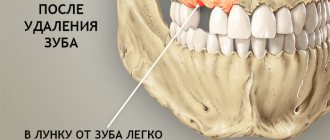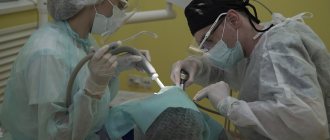Anesthesia during tooth extraction helps eliminate pain and normalize the patient’s psychological state. The variability of techniques makes it possible to select the optimal type of pain relief, taking into account the age, duration and traumatic nature of treatment, and the physical and mental state of the patient. When removing teeth, surface, infiltration and conduction anesthesia is used, and general anesthesia is used if indicated.
Content:
- Options for local anesthesia of a diseased tooth 1.1. Application 1.2. Infiltration 1.3. Conductor 1.4. Intraosseous 1.5. Intraligamentary
- Contraindications
- Pros and cons of local anesthesia in dentistry
To ensure that tooth extraction takes place with maximum comfort for the patient and is not associated with pain, dentists use special painkillers.
If the case is very complex and local anesthetics do not cope, anesthesia is used. Painkillers used in dentistry block the transmission of nerve impulses from the torn unit to the brain. Due to this, all manipulations carried out by a specialist are calmly perceived by a person.
What is sedation?
Sedation is a type of anesthesia that uses sedatives to put the patient into a light sleep.
Kinds:
Pharmacological – used for adult patients, through intravenous administration of the latest generation sedatives.
Oxygen – intended for children, used with a nasal mask.
Main contraindications to sedation
In adults:
- Allergy to local anesthetics
- Neuromuscular disorders
- Pregnancy;
In children:
- Under three years of age
- Cough, runny nose, rhinitis
- Epilepsy;
It is necessary to prepare for the sedation procedure. Firstly, you need to avoid eating 3-6 hours before the procedure, and secondly, avoid drinking alcohol 24 hours before.
Features of tooth extraction in pregnant women
- Pain relief methods such as sedation and general anesthesia should not be used, as this may negatively affect the general condition of the fetus.
- It is possible to use local anesthetics, since the effect on the fetus is minimal
- To obtain a dental image, it is recommended to use a radiovisiograph; X-rays are contraindicated.
- Tooth extraction can be carried out during the period from 13 to 23 weeks of pregnancy, but if there is no urgent need, then it is better to postpone the procedure;
Options for local anesthesia of a sore tooth
Local anesthesia can be conditionally classified into the following groups:
- application;
- infiltration;
- conductor;
- intraosseous;
- intraligamentary.
Let's look at each in more detail.
Appliqué
This type of anesthesia for tooth extraction can only be used if a simple treatment is planned or if the gum area where the anesthetic will be injected needs to be made insensitive. More often, the application technique is used when providing dental care to young children. Baby teeth do not have branched roots and, when they are already thoroughly loosened, before pulling them out, it is quite possible to limit yourself to applying a local anesthetic. The latter usually contains lidocaine or benzocaine.
Infiltration
A very common option for pain relief. Involves injecting the medication directly into the gums. As a result, the treated area, part of the cheek, lip and tongue become numb.
The technique is suitable if the therapy is simple and takes little time, for example, when pulling out baby teeth. It is offered to adults if the unit is already highly mobile and can be easily grasped with forceps.
Anesthesia wears off after tooth extraction within three to four hours. Then the usual sensitivity gradually returns.
Conductor
A more serious option for pain relief. It is used if several teeth need to be removed at once. This is possible if preparation for prosthetics is underway. The doctor makes an injection into the gum and injects an anesthetic. But the needle is installed in such a way that after the injection, not only individual nerve impulses are blocked, but the peripheral branches of the nerve. Due to this, a large area is covered.
Taking into account exactly where the medicine is injected and which tooth is to be removed, conduction anesthesia is divided into:
- Mental. Suitable if you need to pull out canines, incisors, premolars.
- Tuberal. Only used when working with molars.
- Thorusal. It is used if several lower units located in different zones are to be pulled out.
To select the most appropriate anesthesia option for tooth extraction, the doctor examines the oral cavity. In rare cases, the injection is given extraorally. Then the needle is inserted into the gum tissue directly through the cheek.
Intraosseous
With this type of anesthesia, an injection is made directly into the bone tissue. Using a long needle, they reach the bone plate that forms the frame for the tooth. As a result, the surrounding soft tissues remain sensitive and do not go numb.
The intraosseous technique is indicated if it is necessary to remove unerupted and incorrectly located units of the oral cavity. Sometimes it is used when operating on the lower jaw, since it is easier to perform such technically complex anesthesia.
It is important to understand that intraosseous anesthesia renders only the treated tooth numb. If its roots go very deep or intertwine with neighboring ones, it makes sense to use another option for pain relief.
Intraligamentary
The anesthetic is injected directly into the tissue, and not into the nerve, that is, the work is carried out exclusively with the periodontal space. The injection is given under great pressure, but it causes almost no pain.
The intraligamentary technique is optimal if it is necessary to remove premolars, molars, incisors and canines in a child. Sensitivity is lost almost immediately.
Within a minute after the injection, the unit becomes “frozen.” The freezing effect lasts for about 20 minutes. This is quite enough to perform a simple surgical operation.
What types of pain relief are used during tooth extraction?
A classic example of an archaic tooth extraction without any anesthesia is an episode from Chekhov’s story “Surgery.” In modern dentistry, such outright torture does not happen, and tooth extraction without anesthesia is not carried out under any circumstances. If it is necessary to remove 1 - 2 teeth in one visit, the operation is carried out mainly under local anesthesia. However, there are indications for tooth extraction under general anesthesia.
In medicine, the term “general anesthesia” means a state of inhibition of the central nervous system with a temporary immersion of the patient into sleep of varying degrees of depth and loss of pain sensitivity. This reaction of the body is artificially induced using safe anesthetic medications, and it lasts from 30 minutes to 3 hours, depending on the required volume of surgical intervention. For example, removing 4 wisdom teeth under general anesthesia will require a significant amount of time.
Contraindications
Sometimes doctors cannot use anesthetics when extracting teeth. This is due to the contraindications of the drugs themselves and the individual characteristics of the patient’s body.
Among the most common contraindications:
- severe diseases of the cardiovascular system (stroke, myocardial infarction, after which less than six months have passed);
- allergy to compounds included in the painkiller.
If a patient has an endocrine disease that occurs in a decompensated form, he needs to go to the hospital for removal.
It is important to know . To avoid complications after using anesthesia, you need to inform the dental surgeon in advance about all existing chronic diseases, allergies, and medications used.
Types of anesthesia for tooth extraction and methods of its behavior
Based on the depth of anesthesia, anesthesia is divided into the following types:
- surface;
- easy;
- full;
- super deep.
For dental treatment under anesthesia, only superficial and light anesthesia is used in dentistry. While the last two types are used for complex operations, for example, for maxillofacial injuries.
Anesthesia is carried out in two main ways:
- inhalation - you inhale sprayed particles of the drug through a special mask;
- intravenously - using a regular injection.
High-quality anesthetic drugs promote restful drug-induced sleep and recovery from it without any complications. Modern anesthetic medications are highly safe and suitable even for patients with allergies. They do not cause side effects or addiction and are easily eliminated from the body.
Pros and cons of local anesthesia in dentistry
Among the advantages of local anesthesia:
- affordable price;
- lack of significant impact on the patient’s body;
- low risk of adverse reactions;
- the ability to treat and remove baby and molars without pain.
The disadvantages include:
- the possibility of developing allergies, including anaphylactic reactions, laryngeal edema;
- low effectiveness if there is a pronounced inflammatory process in the maxillofacial area.
If the anesthesia method is chosen correctly, the removal will take place quickly and without complications. Trust your health to experienced dentists. Then even the most complex dental problems will be solved quickly and without pain.
Advantages of tooth extraction under general anesthesia
- Anesthesia slows down the body's reactions, due to which the pain is completely relieved. Therefore, all the dentist’s procedures for removing teeth will be completely painless for you.
- Many sensitive patients put off visiting a surgeon until dangerous complications develop simply because they are afraid of the mere sight of surgical instruments. If teeth are removed under general anesthesia, you will not see how the process will occur, but will only wake up when it is over.
- Even for a psychologically stable person, tooth extraction is a stressful situation that negatively affects the body. For example, patients often experience increased blood pressure during this procedure. However, if the operation is performed under general anesthesia, your nerves will not be damaged.
- While the anesthesia is in effect, the dentist will remove the necessary teeth and perform the necessary manipulations, which could take several visits. He will perform all actions carefully and efficiently, which will reduce the risk of complications.
Interesting fact!
According to data from various media sources, at least 2% of adults and 6 - 8% of children, for various reasons, do not have the opportunity to undergo routine tooth extraction using local anesthesia.
Where is a person's wisdom tooth located?
Many people know that this tooth is also called a rudiment, figure eight or 3rd molar.
The name “eight” speaks for itself, since this tooth completes the dentition and is the eighth in a row. There is virtually no benefit to these teeth; they are considered ordinary molars. Formation occurs before the age of 8 and only at the age of 20 do they begin to emerge. The name wisdom teeth was invented back in the old days, because their eruption is equated to the age of maturity in physical and mental terms.
As a rule, the eruption of wisdom teeth is accompanied by pain and discomfort, and in some cases, abnormalities. The latter require surgical intervention.
Basic requirements for modern anesthetics
An anesthetic is a unique substance that suppresses the excitability of the receptor, turns off the impulse to the patient’s nerve fibers, after which pain relief occurs.
The anesthetic has basic requirements:
- do not cause dilation of the patient’s blood vessels;
- do not provoke tissue irritation;
- high resistance to sterilization of the drug;
- slow absorption into the blood;
- greater strength and duration of analgesic effect;
- have low toxicity to the patient;
- good analgesic effect during dental treatment.
The local anesthetic has a direct inhibitory effect on the receptor and the permeability of the sodium channels in the patient begins to decrease, while the entry of sodium into the human cell is completely disrupted, after which an action potential is generated and this all leads to a lack of sensitivity and analgesia during treatment. Sensitivity is switched off one by one: at the beginning pain, then taste, then temperature and finally tactile. This is how the process of pain relief occurs.
To prolong the effect of painless treatment, a vasoconstrictor (for example, adrenaline) must be added to the local anesthetic. However, in patients with heart disease, it poses a greater risk of heart attack. A vasoconstrictor can cause the patient to relax the muscles of the bronchi and intestines, dilate the pupils, significantly increase blood sugar, increase tissue metabolism and cause many adverse reactions. But if you exclude adrenaline from the local anesthetic drug, this will lead to ineffectiveness and the patient will not experience pain relief.
The decision to use this substance in treatment should be made by an experienced dentist, as a last resort. After all, after adding adrenaline to the local anesthetic, the effectiveness of anesthesia itself during dental treatment increases significantly and its toxicity for the patient decreases. This occurs due to the very slow absorption of the painkiller into the blood. And sometimes toxic complications that appear during local anesthesia are mistakenly attributed to a side effect of the substance adrenaline.
When can I do a simple removal?
1. The rudiment has a root system, like other teeth. 2. Most of the tooth is intact. 3. The third molar is not susceptible to caries damage and tartar. 4. Its location is correct and the doctor can easily reach it.
At the clinic, the patient is seated on a dental chair and the oral cavity is examined. An injection produces pain relief. Small incisions are made, and if necessary, the tooth is ground down. Using a special dental instrument, the specialist pries up the root of the third molar and extracts it. Afterwards disinfection is carried out and the bleeding stops. An anesthetic is placed in the place where the tooth grew and anti-inflammatory drugs are prescribed. The patient can return for a re-examination in a week.
Complex wisdom tooth removal
If we talk about complex operations, the leader is the extraction of an impacted tooth that is not able to erupt on its own. Such manipulation is carried out by a highly qualified dental surgeon.
Anesthesia (local) is prepared for the patient. Then the mucous membrane is cut so that it is convenient to get to the roots. In case of a deep tooth location, the doctor cuts out a flap located above the bones. All this also occurs on the mucous membrane, and the cutout resembles the shape of a triangle. Afterwards, holes are made in the jaw to remove the tooth. For such a procedure you will need a drill or ultrasound equipment. Use forceps to remove the figure eight. In case of large sizes, the tooth is removed in parts. An anesthetic is placed in that cavity, which is now empty. And they stitch up the places where the incisions were. Anti-inflammatory drugs are prescribed and are part of complex therapy.
Surgical intervention is also carried out in a similar way when the wisdom tooth is positioned incorrectly. The most complex manipulations include the removal of a tooth where part of the crown has collapsed. Forceps will no longer help here, so specialists use special instruments (surgical, dental). Initially, a flap located in the gum is cut out, after which the part of the figure eight that has been destroyed is removed. Boron is used for this.
If a tooth is cracked, pieces may come loose. In such situations, they are removed from the gums during the intervention. The next month after such an operation, the patient must visit the doctor according to the schedule. The dynamics of recovery will be observed here. And based on this dynamics, individual treatment is selected that is necessary after the operation.
Eating after removal
It is not recommended to eat salty and spicy foods after tooth extraction. They irritate the mucous membrane and increase pain. Consuming hot food and drinks can cause bleeding and increase swelling.
Many people have been afraid to eat ice cream for a long time, claiming that they will catch a cold. Cold food has no effect on this. This problem can be caused by general hypothermia of the body or a draft. The main thing is to eat the ice cream slowly and not bite into large pieces. This delicacy is even recommended, because it forces the blood vessels to constrict, which means that there is no risk of bleeding.
Category Medicines / drugs Published by Mister stomatolog
We remove a wisdom tooth that is not growing properly
The rudiment, compared to other teeth, grows later than all others, so there is not enough space for its growth and the arrangement of neighboring teeth changes, they begin to bend.
In any case, a crooked molar can cause injury to soft tissues, which causes blood and wounds on the gums. If pieces of food remain after eating food, there is a risk of infection.
The worst thing is dystopia, since food not only gets into the soft tissues, but also remains in the interdental space. In this case, the teeth are destroyed as the process of decay begins.
Components of anesthetics
The anesthetic contains local anesthetics, preservatives, vasoconstrictors and stabilizers. The drug used for local anesthesia for pain relief may not contain all of the listed components. To effectively block impulses from nerve endings, one anesthetic is used, and to prolong the period of action and enhance the analgesic effect, vasoconstrictors (adrenaline) are needed. It is used to create and maintain a sufficient concentration of the drug in the treatment area. Preservatives and stabilizers are used in practice to increase the shelf life of anesthesia.
Anesthesia doesn't work
There are cases when the anesthesia does not work and the person feels pain. There are several factors why this happens:
- Alcohol. The chemical composition of ethyl alcohol can block the effects of the anesthetic. Therefore, it is not recommended to go to the dentist if you have recently consumed strong drinks.
- Using large amounts of painkillers. If a person is taking medications that contain painkillers, they should not be taken before seeing a doctor.
- A person may have individual immunity to certain anesthetics. This factor is very rare.
If the anesthesia does not work, then it is worth understanding the reason. Having received the result, the treatment is postponed to another day.
When do you need to see a dentist urgently?
- Severe, acute, throbbing pain that is not relieved by an analgesic, spreads across the face, radiates to the ear, neck;
- bleeding from the socket that does not stop, but rather intensifies;
- absence of a blood clot in the socket;
- bad breath;
- discharge of pus from the wound;
- the formation of yellow, dirty gray, green plaque on the wound;
- temperature rise above 38℃;
- numbness of a part of the face (gums, cheeks) for more than a day;
- pronounced swelling of the gums and cheeks, which does not decrease 2-3 days after extraction.
Antiseptic rinses/baths –
Remember that you should not rinse your mouth vigorously during the first few days after removal, because... you can easily rinse the blood clot out of the socket. Food will constantly accumulate in a hole without a clot and rot there, causing inflammation and pain. It is better to replace rinses with baths (pour an antiseptic solution into your mouth, hold it and spit it out, or lightly “squelch” it).
When are antiseptic baths necessary?
- if the tooth was removed due to inflammation,
- an incision was made on the gum to expose the gumboil,
- if you have teeth with untreated caries or dental plaque, infection in which can lead to suppuration of a blood clot.
Antiseptic baths are best done with an aqueous solution of Chlorhexidine 0.05-0.12%. This drug has a pronounced antiseptic effect and is slightly bitter in taste. Baths should be done 3 times a day (keep the solution in your mouth for about 1 minute each time).
Criteria for choosing a high-quality local anesthetic
The main criterion for choosing an effective local anesthesia will be the nature of the upcoming dental intervention. The doctor selects the drug taking into account the required depth of treatment, the duration of local anesthesia according to the nature and scope of the upcoming intervention. The choice of anesthetic is influenced by pregnancy, great fear of the upcoming manipulation, and possible pathology in the patient. Take into account the presence of contraindications during treatment. There are age restrictions for the use of anesthetics. The dosage of anesthesia for dental treatment of the teeth of young children or elderly patients is always specified.
A cold compress will prevent swelling
Immediately after the manipulations, it is necessary to apply a cold compress, since after tooth extraction the cheek may swell.
To do this, take some chilled meat products or ice and apply it, after wrapping it in a cloth. Such actions will help to minimize or even eliminate swelling of the soft areas of the face that can form in the event of a serious intervention.
It is recommended to keep the ice for about 5 minutes, apply it 3-4 times, taking a break between applications. It is important to apply cold immediately after surgery, since further this action will not bring the desired effect. Under no circumstances should you use a warm compress or warm the tissue in any other way - thoughtless intervention can cause suppuration.











